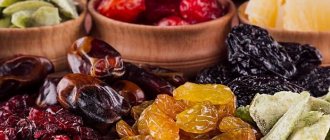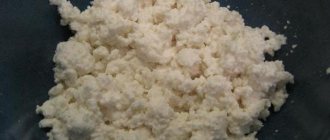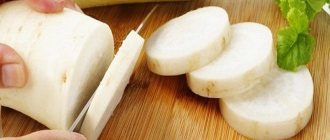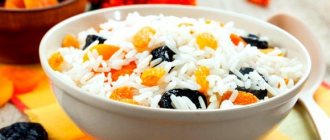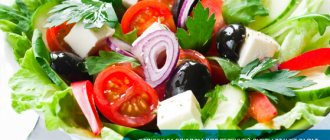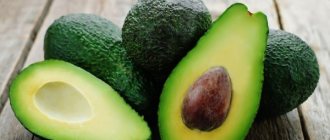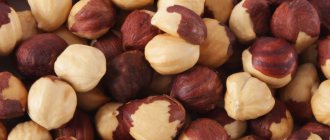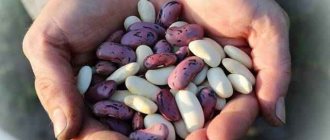Each of us has tried dried fruit compote at least once. Surely, more than half of our readers are crazy about it and love to use this drink in their diet. If you like drinks and salads with dried fruits, read this article, from which you will learn the benefits and harms of dried fruits for the human body.
Let's move on to drying drying
Industrial dried fruits are dried at a temperature of about 200o C. This destroys most of the vitamins and almost all biologically active substances in them. High temperature converts the polysaccharides (complex sugars) present in fruits into simple ones. And this significantly increases their sweetness and, alas, harmfulness: the more complex the sugar, the more energy and time the body needs to spend on assimilating it - and the lower the sugar level in our blood will rise and, accordingly, the less harm will be done to our pancreas , skin and waist.
By the way, just like that - out of innate gastronomic sadism, I note that the high drying temperature makes dried fruits completely non-raw food. After all, according to the canons of a raw food diet, the processing temperature should not exceed 40-42 ° C, and many raw food restaurants prefer to avoid this hot topic with cool silence.
"Hell's brimstone"
Then most of the dried fruits are subjected to so-called sulfiting: to prevent them from darkening, they are treated with sulfur oxide. This tuning gives the dried fruit a commercially bright color and resistance to pests. Smart mold and wise insects avoid sulfated fruits - unlike uninformed buyers.
The fact is that sulfur oxide, when combined with water, forms sulfurous acid. Small amounts of it are considered (supposedly) non-toxic to us. However, pests seem to think otherwise. Apparently, they know something that the merchants are maliciously hiding from us. And, frankly, I happily join the squad of pests - when it comes to dried fruits.
Makeup
Very often, dried fruits are tinted with food coloring (dried apricots and white raisins most often), greased with oil - so that they shine and so that the raisins do not stick together and are crumbly.
Before drying, grapes and prunes are also always scalded with boiling water and sodium hydroxide so that their thick skin, which prevents rapid drying, is covered with a network of microcracks. “Cracking” speeds up the drying process.
And “smoking” prunes is often done with “liquid smoke” - a terrible artificial flavoring that is no less carcinogenic than the “natural” smoke of smoking chambers.
Secrets of choosing dried fruits
Contrary to popular belief, not all dried fruits are necessarily treated with preservatives or dried in industrial ovens. Expensive packaged products, especially imported ones, are indeed treated with chemicals. Natural drying and manual labor are not neglected by producers from the CIS countries, who import dried fruits at the lowest prices in huge quantities. Orchard yields in southern countries exceed domestic consumption, and management's focus is on more profitable exports, such as cotton.
Dried fruits dried in the shade, without treatment with preservatives, are very different from the usual ones. Dried apricots, soft and aromatic, resemble chocolate in color. Dried in the sun, on the contrary, it is very hard and light yellow. It is difficult to chew it without soaking it.
Raisins are black in color, with wrinkled dry skin, and a natural grape bloom of bluish color. Natural apricot seeds are cracked and sweet apricot kernels are consumed in small quantities. Natural pears, apples, quinces are hard, completely dry to the touch, darkish, very cheap and incredibly healthy.
Sweet-faced
The sweeter the fruit, the more attractive it is to the buyer. I scared you above by the fact that polysaccharides that are beneficial to us at high temperatures turn into unhealthy sugars. But this is not the worst thing! Commercial dried fruits (dried apricots, figs, apples, persimmons, prunes, etc.) are also soaked in water with sugar and then dried again. All this is done in order to make the product even sweeter, softer and more commercially interesting.
I often write on my Facebook page about exactly how high blood sugar (glycemic index) levels contribute to fat accumulation, sagging skin and addiction to baked cookies and candy. In the meantime, I will continue to terrify you.
Are dried apricots healthy?
Dried dried apricots are also useful, but can also be harmful. Dried apricots are made from apricots. This product is famous for its large number of minerals, pectins and organic acids. Dried apricots remove compounds of harmful metals, as well as radionuclides, from the body. It has a positive effect on the functioning of the cardiovascular system, strengthens vision and maintains its sharpness. Helps in the treatment of diabetes, thyroid and kidney diseases.
If you use antibiotics, then introduce dried apricots into your diet, it will reduce their negative effects on the body.
Dried apricots are contraindicated for those who suffer from low blood pressure and periodic stomach upsets. Due to its high nutritional value, it should not be eaten in large quantities.
Santa Claus or Santa Claus?
Have you already fearfully directed your distressed gaze at homemade dried fruit? Very in vain! Yes, it is tatty, brown and dried at room temperature. But even this does not make it a particularly healthy food. The fact is that almost any fruit and vegetable contains enzymes that destroy vitamins. When storing a fruit (and a vegetable, too, by the way) at room temperature, these serial vitamin killers become active and destroy most of the beneficial content in the fruit. Therefore, fruits and vegetables, by the way, should only be stored in the refrigerator.
Table 1 shows average data on the destruction of vitamins during rapid drying in home dryers at low temperatures. And with slow drying and high-temperature drying, losses, accordingly, increase significantly.
Table 1
Typical Loss of Nutritional Benefits from Processed Foods Compared to Raw Foods
| VITAMINS | FREEZE | DRYING | BOILING, PRESERVATION |
| VITAMIN A | 5% | 50% | 25% |
| ALPHA CAROTENE | 5% | 50% | 25% |
| BETA CAROTENE | 5% | 50% | 25% |
| LYCOPINE | 5% | 50% | 25% |
| LUTHEIN + ZEAXANTHIN | 5% | 50% | 25% |
| VITAMIN C | 30% | 80% | 50% |
| THIAMIN | 5% | 30% | 55% |
| RIBOFLAVIN | 0% | 10% | 25% |
| NIACIN | 0% | 10% | 40% |
| VITAMIN B6 | 0% | 10% | 50% |
| FOLIC ACID | 5% | 50% | 70% |
| VITAMIN B 12 | 0% | 0% | 45% |
As you can see, most vitamins are stored in frozen fruits and vegetables. But if you leave fruits and vegetables to defrost at room temperature, then within a few hours most of the vitamins will also be attacked by “antivitamins” and will be destroyed. Therefore, it is better to bring the “scumbags” to an edible temperature in the microwave using a special “defrost” mode.
Microwave macro pleasures
Along the way, I will please you (not out of innate gastronomic humanism, but because the author is obliged to tell the reader something challenging so that he continues to read the article further). I have not found a single real scientific study that convincingly proves the harm of using microwaves. But there are plenty of studies that show the opposite. And they all say that microwave cooking retains more vitamins and other nutrients than most other types of heat treatment.
If, say, shriveled brown dried apricots dried on a tree under the sun, or apples and pears are in grandma’s attic under the roof (which is heated by the same sun), then the process of destruction of vitamins goes much further. And in the end we get a homemade, but very, very vitamin-free product.
Is there any harm from dried fruits?
As we have already summarized earlier, dried fruits can cause harm to people suffering from diabetes, hypertension, and those who want to lose weight if they neglect the recommended amount of dry fruits. Otherwise, dried fruits will be harmful in case of improper cultivation, spraying with chemicals and, as a result, poor processing, drying and transportation of fruits. The appearance of the fruit will tell you this. For example, if it is too bright, it means the fruit was treated with chemicals during cultivation or processing. Excessive consumption of dried fruits in unlimited quantities can also cause harm.
We believe that you have now made a conclusion about the benefits and harms of dried fruits in your diet and will make the right decision regarding their consumption. We also ask you not to forget about fresh seasonal fruits, rich in the same vitamins and minerals, and we ask you not to exclude them from your menu.
Don't thorn the rose hips!
For the sake of another consolation, I will add that ascobate reductase (an enzyme that destroys vitamin C) is completely absent in rose hips. Which contains, at the same time, an indecently huge amount of ascorbic acid (vitamin C). Nature, apparently, tried to create a special ascorbic acid product for the northerners. So steaming rose hips in a glass thermos is a very decent option for home winter vitaminization.
Just buy rose hips that have not been sitting in the sun on the market, and brew it only in a glass thermos: contact with iron (even stainless steel) catalyzes the oxidation of vitamin C.
Low-vitamin multifruit
So, ALLEGEDLY the most useful, as you already sadly understand, are, of course, fruits and berries dried independently in home dehydrators. It’s “supposedly” - because here we move on to the most interesting and, at the same time, the most upsetting.
The fact is that of all the fruits and vegetation available to us, fruits are the poorest in vitamins. Most vitamins, biologically active substances and microelements accumulate in greens. Berries and peppers modestly follow. Then - all the vegetables (especially cabbage, and especially broccoli and cauliflower). And only then - other vegetables and, at the very end - fruits (even citrus fruits) and leaf salads.
Table 2 is part of the general tables of the content of useful nutrients, which I once, in a fit of tireless curiosity, compiled. I have noted in these tables those beneficial ingredients whose amount exceeds 10%.
Of all the vitamins in fruits, only C, K and beta-carotene were found in noticeable quantities. All other utilities turned out to be significantly below the ten percent passing barrier, and I simply did not reflect them in the table.
table 2
The content of vitamins in fruits is more than 10% of the daily value
| Product content in % of daily value per 100 g. | Vitamin C | Vitamin K | Carotene |
| Black currant | 263 | ||
| Persimmon | 53 | 24 | |
| Apples | 24 | ||
| Blueberry | 45 | 16 | |
| Apricots | 11 | 32 | |
| Banana | 10 | ||
| Grape | 12 | ||
| Cherry | 11 | 15 | |
| Pear | |||
| Melon | 22 | ||
| Strawberry | 86 | ||
| Raspberries | 37 | ||
| Peach | 10 | ||
| Plum | 14 |
Now imagine: 100 g of the freshest apricot contains on average 45% vitamin C, and an apple picked from a branch contains 24%. After drying, they will lose 80% of ascorbic acid.
100 g of apricot contains a very insignificant 9% of the daily value of vitamin C, and 100 g of apples contains only 5%. We don’t even talk about the rest of the vitamins, we just take off our hats and honor their eternal memory with mournful silence. And at the same time, dried (even at home!) apples and apricots contain about 210-250 kcal and 40-45 g of easily digestible carbohydrates, and a handful of potassium, iron, zinc, magnesium, etc. Actually, these microelements are almost the only value of dried fruits, besides pectin (fruit fiber).
The benefits of dried fruits
Source of natural antioxidants
Free radicals destroy DNA and body cells. Large oxidative processes provoke cancer and severe damage to the body. Antioxidants present in all dried fruits fight free radicals. They are most abundant in dried pears, raisins, and prunes.
High energy value
Due to their high sugar content, dried fruits perfectly satisfy hunger and nourish brain cells. When dried, fruits lose water and the calorie content of the product increases. Thus, the calorie content of 100 g of raisins is 264 kcal and corresponds to approximately 400 g of grapes.
High content of vitamins and microelements
Dried fruits are a concentrated source of nutrients. The content of microelements in them is several times higher than that of fresh fruits. Dried apricots contain a lot of potassium, which is good for the heart, and vitamin E. Raisins are a source of boron, phosphorus, and iron.
Prunes contain the natural laxative sorbitol, which stimulates the intestines even in small doses. 100 grams of product contain 49.6% of the daily value of vitamin K.
High concentrations of vitamins:
- Carotenoids (converted to vitamin A in the body)
- Group B (among the “vitamins” are thiamine, folic acid and others)
- Nicotinic acid (enzymes of carbohydrate, protein, fat metabolism)
- Other vitamins, depending on the type.
Microelements:
- Potassium (necessary for proper heart rhythm)
- Calcium (99% of calcium in the body is found in bones and teeth)
- Magnesium (nerve and muscle health)
- Phosphorus (muscle health, mental performance)
Helps remove toxins from the body
In addition to vitamins and microelements that help remove toxins, dried fruits contain non-digestible plant fibers - fiber. Its insufficient consumption is considered one of the causes of intestinal cancer. Consumption of fiber helps remove toxins, cleanse the intestinal walls, and lower cholesterol and sugar levels. It is fiber that feeds the beneficial bacteria that live in the gastrointestinal tract. Soluble fiber normalizes stool.
Prevention of serious diseases
Dried fruits are rich in plant sterols: 100 grams of dates contain 66.8% of the daily value of phytosterol. Scientists have experimentally established the anticancer properties of this substance. Phytosterols are involved in cell formation and reduce the absorption of “bad” cholesterol by the intestines.
Useless snack
Many people perceive dried fruits as a healthy alternative to cookies and sweets for a coffee break. Yes, 100 g of sushi will satisfy (very temporarily) your hunger. But at what cost? Due to easily digestible carbohydrates, any product with a high glycemic index (and dried fruits are exactly that) first sharply raises the blood sugar level, and then this level drops just as sharply. Moreover, it drops to a level that is perceived by the body as acute and severe hunger. Just the kind of thing you wanted to get rid of with a dried fruit snack.
High blood sugar causes high insulin levels, and insulin directly causes fat cells to store fat. The one that you want to get rid of with a “healthy snack”.
Dried fruits and uzvar: benefit or harm?
Probably, many have heard about such a drink as uzvar, whose homeland is Ukraine. Uzvar is a decoction made from dried fruits. Once upon a time, uzvar was prepared only for Christmas, but now you can buy it, or better yet, prepare it yourself at home, at any time of the year.
- Uzvar has a pleasant taste and is in many ways reminiscent of compote, but many will notice that it is even tastier and is something between pear juice and a drink made from dried fruits. To prepare the drink, take dried pears, a little less apples and raisins. You can also supplement the cocktail with dried apricots, prunes, cherries, and hawthorn. The benefits of uzvar are influenced by those components that are included in its composition. Accordingly, as we already know, uzvar, due to dried fruits, will be rich in fiber, glucose, pectin, and antioxidants. You will be able to strengthen the immune system, improve the functioning of the cardiovascular system, remove salts and toxins from the body, improve intestinal function, etc.
- It is known that uzvar is an excellent hangover cure. It perfectly invigorates and improves a person’s well-being. In order for the benefits of uzvar for the body to be the same as we describe it, the drink should be prepared correctly. To prepare, start cooking dried fruits in the same way as when preparing regular compote. Rinse the fruit thoroughly, add clean spring water, then place on the stove and remove as soon as the water boils. To enhance the flavor and yield of the fruit, pre-soak it, either 15 minutes before cooking or overnight. The proportion for preparing such an energy cocktail is as follows: for 400 grams of fruit, take 2 liters of water and 250 grams of sugar, as well as 1.5 tablespoons of honey, which can also be a complete alternative to sugar. You can prepare uzvar in a simpler way - simply pour boiling water over the fruits and let them steep thoroughly under the lid. Honey must be added to an already cooled drink.
Fructose dose
The second stimulator of fat accumulation is fructose. The same supposedly healthy and dietary product that the “healthy” food industry feeds us with. I will talk about how large amounts of fructose cause depression, provoke fat accumulation and damage the liver in one of the episodes of the program “CHECKING SUBSTANCES.” For now, I’ll just note that dates – even fresh ones – are the most high-fructose fruits. Most of the sweetness they contain is harmful fructose. Can you draw your own conclusions?
Is dried fruit worth the hassle?
If you continue to experience hunger pangs, then it is best to extinguish them with something less high-glycemic. For example, raw vegetables and fruits. Then you will get hungry again much later, and at the same time you will benefit from the vitamins contained in them. Vitamin C, by the way, invigorates quite noticeably. A couple of oranges or a bunch of parsley awakens you just as much as a cup of coffee.
And if the main meals are gradually made more and more healthy, that is, more and more low-glycemic, then the need for snacks will gradually disappear. Which is exactly what you and I are trying to achieve.
And I talk about how to properly and tasty switch to a low-glycemic diet in my lectures and write on my Facebook page Max Pogorely. Health studio. Welcome!
Conclusions: sad, but delicious!
Oh, how many harmful things are hidden among the useful! You now understand that if wet fruits in my health and weight loss nutrition system are completely respected members of society, then their mummified remains cause me much less excitement.
The undoubted advantage of dried fruits, compared to cakes and chocolates, is, of course, the presence of pectin, fiber and a certain (albeit small) amount of mineral salts. The undoubted disadvantage is the almost complete absence of vitamins and a clear excess of various sugars and fructose. In fact, dried fruits are almost the same as candies, but containing fiber and a bit of microelements.
Conclusion: it is wisest to put dried fruits not in your mouth, but on a shelf. I mean - a store or market one, on which they lay peacefully until your sweet-loving hand habitually reached out for them. And switch to fresh fruits and vegetables. They are the ones who will allow you to maintain the freshness of your body and good spirits, which is what I wish for you with all my heart!
The information was published on www.fireinspire.com.ua. Author: Max Pogorely.
How to properly consume dried fruits?
It would seem that there is nothing simpler - I ate dried fruit and that’s it. However, in practice it turns out that not everything is so smooth and even a healthy person needs to be able to take dried fruit and prepare it. Let's briefly talk about the basic rules:
- Moderation. In no case should you neglect the intake of dried fruits and gorge yourself on them. A small amount of dried fruits in the diet is enough to provide benefits to the body. For example, it could be rice porridge supplemented with several dried apricots or a fruit salad with raisins.
- Drink a glass of water before eating dried fruits. This will improve digestion; in addition, dried apples or pears, for example, are a good diuretic. Water can also be replaced with juice or warm tea.
- Don't add sugar. For example, if we are talking about compote, then it must be cooked without adding sugar, since it is sugar that deprives the fruit of its beneficial properties. If you cannot drink compote or eat porridge without sugar, then it would be acceptable to add a spoonful of natural honey.
- Be careful when taking medications. Caution should be exercised when consuming antibiotics and dried pineapples, which may well speed up the effect of the medicine.
- Follow the recommendations. Remember that you should not eat dried cherries if you are constipated, or if you have increased acidity of gastric juice, obesity, diabetes, or ulcers. If you have diseases and abnormalities in the functioning of the digestive organs, you should also pay attention to dried pears, the use of which should be avoided for a while.
- If you manage to try dried melons, eat them separately from other foods , maintaining a time interval of at least an hour.
- If you are obese, avoid raisins, and also exclude them from your diet in case of heart failure, ulcers, or diabetes.
- Do not take figs if you have pancreatitis , diabetes, inflammation of the digestive system, or if your body has a tendency to form stones.
- Also exclude dried apricots and papaya from your diet if you have diabetes.
